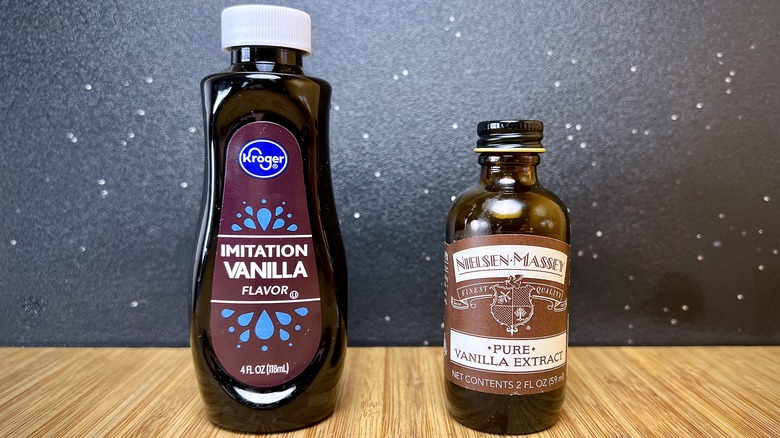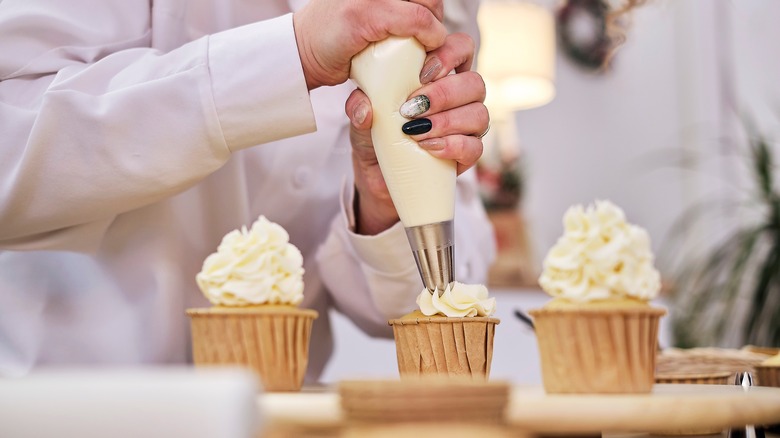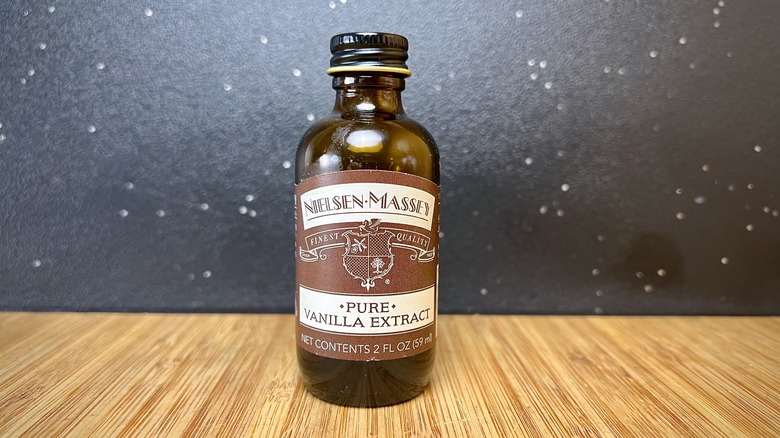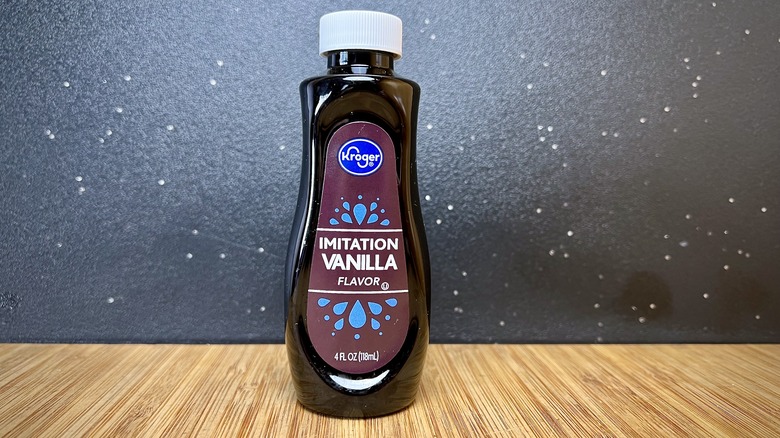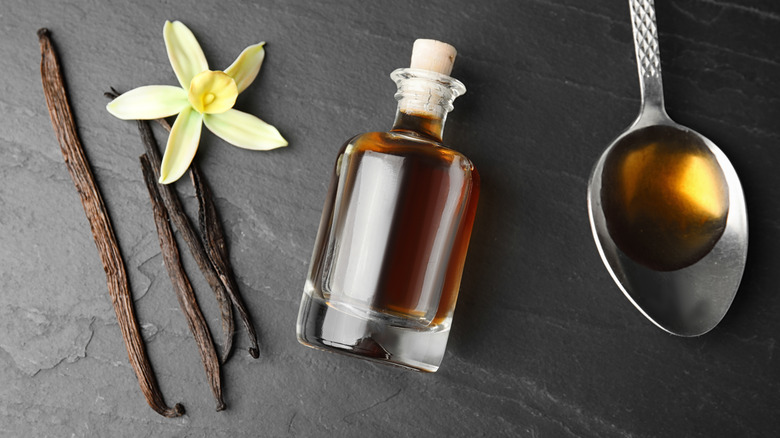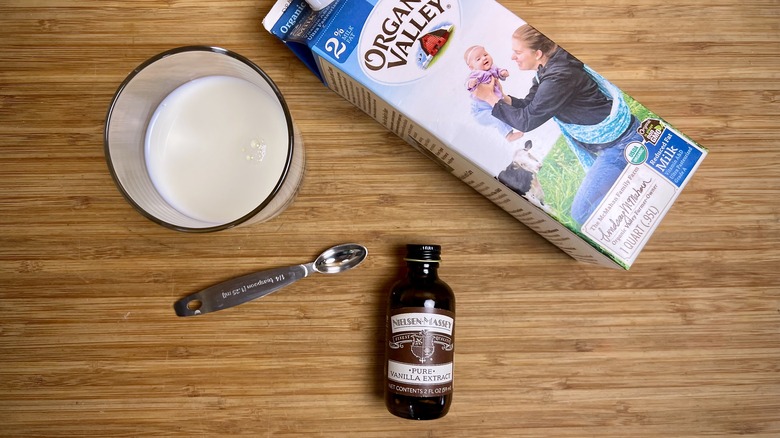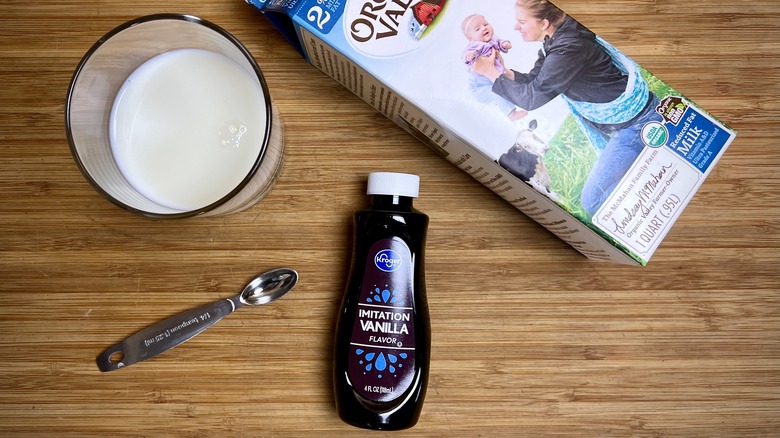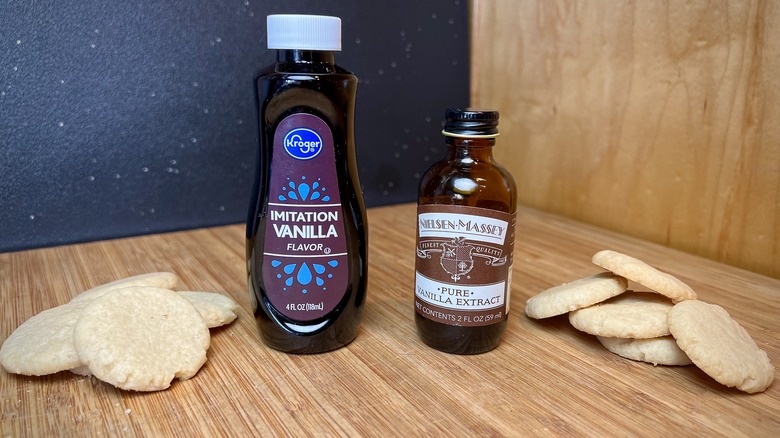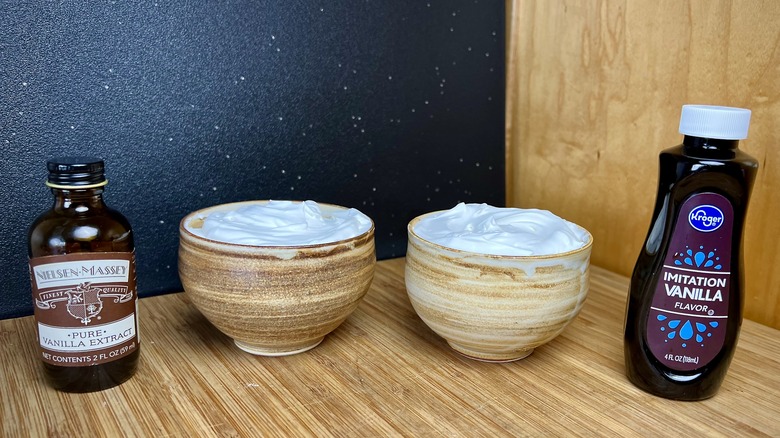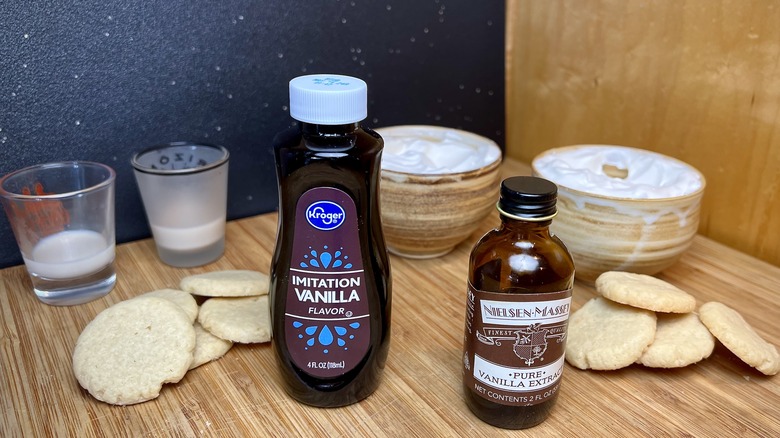Pure Vs. Imitation Vanilla Extract: Is It Worth Spending More For The Real Stuff?
Standing in front of the extracts at the grocery store can be a little overwhelming. There are so many choices, from the different types of vanilla on the shelf to the price disparity between all those little jars. If you lean in and look closely, you'll notice something interesting: Some of them say "pure vanilla extract," while others are clearly marked as an imitation vanilla flavor.
We started wondering whether purchasing the real stuff was really worth the extra charge. So, we picked up a jar of pure vanilla extract and put it through a set of tests to compare its flavor and aroma to an inexpensive imitation vanilla flavor. After tasting the two straight out of the jar and mixed into milk, we compared their flavors in vanilla-scented whipped cream and baked vanilla wafer cookies. After a blind taste test, all the tasters agreed that price isn't always an indicator of quality.
Ways to use vanilla extract
The most common way to use vanilla extract is in pastries and other baking recipes. You might not be able to taste the small amount of vanilla when it's added to cakes, muffins, and cookies, but it enhances the other flavors by bringing out the sweetness of the sugar or reducing the eggy flavor for recipes containing raw eggs. That same enhancing power works for savory recipes as well as sweet ones.
For example, we love adding vanilla extract as our secret weapon for stunning caramelized veggies. It not only adds a gorgeous brown color to the onions, but the vanilla extract also lends a bold sweetness to the dish as it evaporates. That same principle works when adding vanilla extract to marinades or dressings, so don't be afraid to experiment with savory vanilla additions. When it comes to drinks, adding vanilla extract to hot drinks (like hot chocolate) is a great way to add depth of flavor to a classic drink. It's also a natural pair for bourbon- or rum-based cocktails, where it can be used in a similar fashion to bitters as added by the drop.
Why you might want to opt for the real deal
Pure vanilla is so expensive because of the vanilla beans themselves, which are the second most expensive spice in the world (after saffron). Vanilla is a member of the orchid family, and the beans are the fruit produced by the flowers. They're known for being extremely hard to grow, primarily because they're limited to growing about 10 to 20 degrees north or south of the equator, but also because the flowers have to be hand pollinated. All that drives up the price of the world's somewhat limited stash of vanilla.
Proponents say real vanilla extract is worth the extra price because the flavor and aroma are unmatched compared to artificial vanilla flavoring. That purity comes from the process of making vanilla extract, which involves splitting the vanilla bean to expose the seeds. From there, the beans are soaked in alcohol to extract their essence. Homemade versions use brandy or vodka but commercial vanilla is made with pure ethyl alcohol. Over time, the alcohol pulls out the flavor and aroma of the vanilla and transfers it to the liquid. The spent vanilla pods can be dried and blended with sugar or salt, just like you would with scraped vanilla bean pods.
How imitation vanilla became a thing
Imitation vanilla came into the world in 1858 when chemists found a way to synthetically replicate vanillin, the compound responsible for vanilla's flavor and aroma. Originally, the key ingredient to imitation vanilla was coal tar, but scientists also derive this compound from paper, cinnamon, cow manure, or petroleum.
Regardless of how it's made, this compound is inexpensive to make — especially when compared to real vanilla. It's likely that most of the vanilla-flavored products you purchase are made with imitation vanilla, from ice cream to whey protein and sugary syrups for flavoring lattes. You'll know if you're consuming something with imitation vanilla if you know what to look for on the label. The U.S. Food and Drug Administration has regulations around labeling, and it requires that true vanilla extract is in a 35% alcohol solution and contains 13.4 ounces of vanilla beans per gallon. Anything made with imitation vanilla must be labeled as "artificial" or "imitation" vanilla.
Pure vanilla extract is significantly more expensive
Vanilla prices range widely depending on the brand, the type of vanilla, and the packaging. At our local Fred Meyer grocery store, the pure vanilla extract we purchased was $10.99 for a 2-fluid-ounce bottle (or $5.49 per ounce). The store-brand imitation vanilla flavor was $3.69 for a 4-fluid-ounce bottle (or $0.93 per ounce). That is a huge disparity, but luckily most of us only use vanilla in small quantities. A teaspoon called for in most baked goods contains 0.17 fluid ounces, so we're really talking about a difference between $0.93 and $0.15 per use.
It's also worth noting that pure vanilla extract lasts for about a decade, even after it's been opened. The alcohol in pure vanilla extract will begin to evaporate after some time, but it takes a while to get there. The synthetic imitation vanilla only lasts for four years, which is still a pretty long time. When we put it all together, the investment in an expensive bottle of vanilla doesn't sound as bad as it did at first glance.
Can you substitute one for another?
You might think these two substances are vastly different from one another based on the ingredients label, but it is possible to substitute one for another in equal parts substitutions. As you'll learn from our taste test, pure vanilla extract has a noticeably alcoholic flavor, while the imitation product has a stronger presence of vanilla flavor. However, once used in recipes (especially baked goods), the differences melt away and both provide a similar character to sweet or savory dishes.
In general, you can also use this rule of thumb when substituting for other vanilla products. If your recipe calls for one teaspoon of pure vanilla extract, feel free to swap in one teaspoon of imitation vanilla, vanilla paste, or vanilla powder. When considering vanilla paste vs. vanilla extract, the former has a thicker, more syrupy texture, and vanilla powder is a great vanilla extract swap for deeper flavor. If you happened to have a vanilla bean pod in your pantry, you could use it as a substitute (one vanilla bean pod equals about one tablespoon of other vanilla products, in case you were wondering).
What does pure vanilla extract taste like?
The first thing we noticed about the pure vanilla extract was its intoxicating aroma. It smelled lightly sweet and oaky like a wine barrel and reminded us of flowers or perfume. Just by taking a whiff, we could sense the potential of this aromatic liquid. We could almost smell the sweetness of a sugar cookie or the richness of a buttery pound cake.
We tasted the pure vanilla extract in two ways. First, we poured it straight onto a spoon and gave it a little sip. This certainly wasn't our preferred way of consuming vanilla extract, as the alcohol content was very prevalent. The first thing we tasted was a sharp, alcoholic bite, creating heat on the back of our tongues as we swallowed. Like a shot of whisky, this heat lingered long after we had finished and it felt spicy on our palate. We did taste a light sweetness, but no presence of vanilla flavor.
To tame that alcoholic flavor, we mixed one teaspoon of vanilla extract into a tablespoon of milk and let it sit for about five minutes. This was our preferred way to understand the nuances of the extract, as the milk tamed the alcoholic edge and allowed the flavor to be experienced on a deeper level. We tasted sweet, rich vanilla notes in the milk, but the alcohol flavor was still sharp and present.
What does imitation vanilla extract taste like?
We expected to be able to identify the imitation vanilla by the smell, but it had a similar aroma to the real vanilla. It was perhaps a little sweeter on the nose, and we caught notes of warm spices like cinnamon or cloves. When we poured it onto the spoon, we immediately noticed that it was a deep mahogany color — much darker and more opaque than the real extract.
On its own, the flavor was overwhelmingly cloying. It didn't have any alcohol notes, but it did have a lightly bitter edge. The warming spices we noticed on the nose also came through in the flavor, rounding out the vanilla flavor with light woody notes. When mixed with milk, the dairy tamed the imitation vanilla's bitterness, and the cinnamon flavor was a little brighter. It tasted good, and we would almost drink this straight! If we were being picky, there was a lightly chemical aftertaste and a slight astringency, but it mostly tasted like a vanilla latte or candied milk.
Could we taste the difference between the two in baked goods?
Our next step was to see how the two tasted in baked goods. Would we be able to tell the difference? We whipped up a simple vanilla wafer cookie made with butter, sugar, eggs, flour, baking powder, salt, and vanilla. We didn't notice any difference in the texture of the two batches, either before we baked the dough or after they came out of the oven. Looking at the two products, you couldn't tell that one was made with pure extract and the other with imitation vanilla.
In our blind taste test, the tasters admitted that they wouldn't have known the difference between the two cookies if they weren't trying to be critical. Since they were specifically looking for a distinction between the two, they found the cookie with imitation vanilla was a little sweeter and contained slightly more vanilla flavor. The cookie with real vanilla extract was richer, but — surprisingly — it tasted less like vanilla. Overall, it was a slightly better cookie, as it brought out the buttery flavor a little more than the imitation version. The overwhelming impression is that the imitation tasted more like a box of cookies while the pure vanilla extract tasted more like a cookie you'd get at an artisanal bakery.
What about a no-bake recipe like whipped cream?
We also wanted to taste the vanillas in a no-bake recipe. Since heat can cause liquid to evaporate, it stood to reason that the flavor of the two would change in the oven. So we made two batches of whipped cream from heavy whipping cream, powdered sugar, and vanilla. We added a little more vanilla than we normally would for a whipped cream recipe to make sure we could really assess the difference between the two.
In this taste, our tasters agreed they would have spotted the differences even if they weren't looking for them. The imitation vanilla was exceptionally sweet, and it seemed to accentuate the sugar in a bold way. Most of the tasters said it reminded them of marshmallows or caramel candies, but this one also had a slight aftertaste that no one enjoyed. The pure vanilla extract was the clear winner in this test. It was delicate, adding a light sweetness without any noticeable lingering flavors after we finished eating. The vanilla notes came through like a flower, adding a beautiful fragrance and a fantastic depth of flavor to the whipped cream.
The verdict: Does it matter which one you buy?
When it came down to it, the tasters decided that it didn't really matter which vanilla was used. While the real vanilla had a more pure flavor and aroma, it was barely noticeable once the cookies were baked. And even though they all preferred the real vanilla in the whipped cream, they all agreed that the aftertaste of the imitation vanilla version wasn't actually bad enough to avoid in the future.
What it comes down to is this: If you have the budget to buy real vanilla and you really want to impress your guests, splurge for the bottle of pure vanilla extract. We loved the way it accentuated the buttery flavor in the cookies and it clearly made a more nuanced whipped cream. However, if you don't want to make the investment, the imitation bottle is totally fine. It seemed to bring out sweetness no matter how we prepared it, so it may be the better choice for accentuating sweet flavors anyway. And since it lacks alcohol, it would be our top choice for making uncooked beverages, especially if you're serving underage guests.
